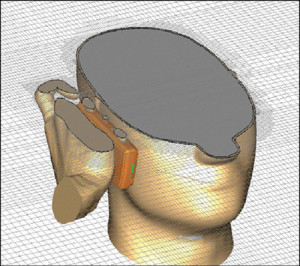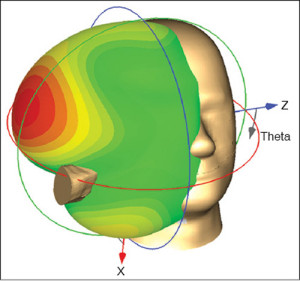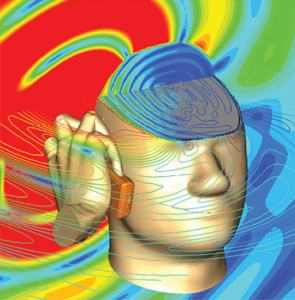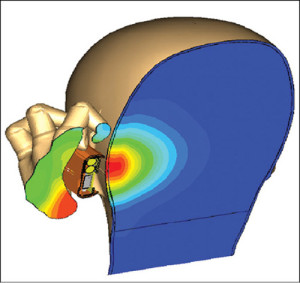Once the designing of a mobile phone is completed (assuming it in free space), the performance of the phone needs to be tested in more realistic surroundings such as near the head and when placed in the hand. This is important since the field distribution and radiation pattern will be influenced by the head and hand. Finally, for certification, SAR also needs to be proven to fulfil international standards such as the IEEE (Institute of Electrical and Electronics Engineers) C95.3 standard.
Due to the fact that measurements in true biological heads cannot be carried out, SAR norms for mobile phones or electromagnetic interference problems are commonly defined in terms of standardised phantom models. In the easiest case only spherical structures are considered. To predict the SAR behaviour of a new product already in the design stage, it is suggested to include the phantom head in EM simulations.
EM simulation of the mobile phone is conducted on several system complexity levels, such as the simple antenna design and the printed circuit board (PCB), to the complete phone structure containing several hundred components and finally the entire system using the head of the standard anthropomorphic model (SAM), a homogeneous hand model and the phone (Fig. 1). The complete CAD model of the mobile phone is imported in CST MWS as a step-file. In addition, the SAM phantom head and a phantom hand are imported.




In real mobile phones, many objects in the vicinity of the antenna element have to be considered because of their effect on the performance of the system. Therefore great care must be taken when selecting and setting correct simulation parameters for relevant objects. The analysis of antenna performance in the vicinity of bodies often comprises assumptions and simplifications. In general, homogeneous bodies are used in order to measure the most conservative behaviour of the system. Because of this, homogeneous head and hand models are used for simulations as well.
In accordance with International Electrotechnical Committee (IEC) and IEEE standards, SAM is used as the head model. This head phantom model is filled with a liquid that correlates with the dielectric properties of the human head tissue. The dielectric properties of the head tissue are calculated taking into account the properties of the human brain tissue and the matching effects of the outer tissue layers of the head (e.g., skin and skull) to provide a conservative overestimate of the values. The frequency-dependent dielectric properties of the tissue-simulating liquid are also defined by IEEE standard (see the table).
Simulation of the mobile phone, with head and hand models, requires tens of millions of mesh cells and a simulation run-time of five to six hours on a PC (Intel Core i3 CPU, 64-bit operating system, 2.13GHz, 4GB RAM). The number of mesh cells can be reduced using the sub-gridding scheme. When applied, a very fine mesh is created inside the phone, a coarser one in the head and a very basic one in the vacuum (Fig. 2).
Due to high dielectric permittivity of the order of 40 in the brain tissue, the mesh needs to be much finer in the head region than the surrounding vacuum. In classical time-domain solvers, these fine mesh lines need to be extended to the boundary of the computational domain. However, the sub-gridding scheme in CST MWS allows different levels of mesh to be used for different solids in the model. Its use reduces the number of mesh cells required and also the simulation run-time.
Such a simulation can give an important insight into how the SAM phantom or the homogeneous body models affect the performance of the mobile phone. The resulting electric field distribution at 1800 MHz is shown in Fig. 3. It clearly shows how the wavelength inside the head is shortened compared to the vacuum, due to high dielectric values. The radiated field is basically guided around the head.
The far-field plot (Fig. 4) shows that the main radiation direction is located between the hand and the head.
For certification of the mobile phone, SAR is expected to be compliant to the SAR standard IEEE C95.3. Currently, the SAR value needs to be measured, but in the design stage it is very useful to check this value through simulation. In the near future, pure simulation may be sufficient for certification.
The ‘SAR 10 gm’ is the maximum SAR value averaged on 10 gm, which is obtained by averaging the SAR around each point in the volume and adding the nearest points till an average mass of 10 gm is reached with a resulting volume having the shape of a portion of sphere. The contiguous SAR 1 gm is estimated by averaging the local maximum SAR, adding the highest SAR volume in a given tissue till a mass of 1 gm is reached. SAR (point) is the local value of SAR at every point inside the head model.
Fig. 5 shows distribution of the SAR value averaged over 1gm tissue mass. It is clear that the radiated field is basically guided around the head and varies inversely with distance. This leads to an automatic inference that SAR and hence the health effects within very close proximity of head would be harmful. Thus it is clear that a person using a mobile phone 30-40 cm away from his body will have a much lower exposure to radio-frequency fields than someone holding the handset against his head. So it is recommended to keep mobile phones away from your body as much as possible.
The author is working with Bharat Sanchar Nigam Limited as a junior telecom officer and is currently posted at Ludhiana, Punjab. He is a PhD in electronics engineering from Indian Institute of Technology-BHU, Varanasi









